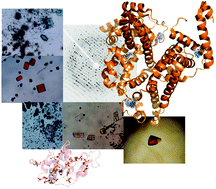当前位置:
X-MOL 学术
›
Metallomics
›
论文详情
Our official English website, www.x-mol.net, welcomes your feedback! (Note: you will need to create a separate account there.)
Principles and methods used to grow and optimize crystals of protein–metallodrug adducts, to determine metal binding sites and to assign metal ligands
Metallomics ( IF 3.4 ) Pub Date : 2017-09-20 00:00:00 , DOI: 10.1039/c7mt00219j Irene Russo Krauss 1, 2, 3, 4, 5 , Giarita Ferraro 1, 2, 3, 4, 5 , Andrea Pica 6, 7, 8 , José A. Márquez 6, 7, 8 , John R. Helliwell 9, 10, 11, 12, 13 , Antonello Merlino 1, 2, 3, 4, 5
Metallomics ( IF 3.4 ) Pub Date : 2017-09-20 00:00:00 , DOI: 10.1039/c7mt00219j Irene Russo Krauss 1, 2, 3, 4, 5 , Giarita Ferraro 1, 2, 3, 4, 5 , Andrea Pica 6, 7, 8 , José A. Márquez 6, 7, 8 , John R. Helliwell 9, 10, 11, 12, 13 , Antonello Merlino 1, 2, 3, 4, 5
Affiliation

|
The characterization of the interactions between biological macromolecules (proteins and nucleic acids) and metal-based drugs is a fundamental prerequisite for understanding their mechanisms of action. X-ray crystallography enables the structural analysis of such complexes with atomic level detail. However, this approach requires the preparation of highly diffracting single crystals, the measurement of diffraction patterns and the structural analysis and interpretation of macromolecule–metal interactions from electron density maps. In this review, we describe principles and methods used to grow and optimize crystals of protein–metallodrug adducts, to determine metal binding sites and to assign and validate metal ligands. Examples from the literature and experience in our own laboratory are provided and key challenges are described, notably crystallization and molecular model refinement against the X-ray diffraction data.
中文翻译:

用于生长和优化蛋白质-金属药物加合物的晶体,确定金属结合位点和分配金属配体的原理和方法
表征生物大分子(蛋白质和核酸)与金属基药物之间相互作用的特性是了解其作用机理的基本前提。X射线晶体学能够对此类配合物进行原子级细节分析。但是,这种方法需要制备高度衍射的单晶,衍射图样的测量以及从电子密度图对大分子-金属相互作用进行结构分析和解释。在这篇综述中,我们描述了用于生长和优化蛋白质-金属药物加合物的晶体,确定金属结合位点以及分配和验证金属配体的原理和方法。提供了来自我们自己实验室的文献和经验中的示例,并描述了主要挑战,
更新日期:2017-11-16
中文翻译:

用于生长和优化蛋白质-金属药物加合物的晶体,确定金属结合位点和分配金属配体的原理和方法
表征生物大分子(蛋白质和核酸)与金属基药物之间相互作用的特性是了解其作用机理的基本前提。X射线晶体学能够对此类配合物进行原子级细节分析。但是,这种方法需要制备高度衍射的单晶,衍射图样的测量以及从电子密度图对大分子-金属相互作用进行结构分析和解释。在这篇综述中,我们描述了用于生长和优化蛋白质-金属药物加合物的晶体,确定金属结合位点以及分配和验证金属配体的原理和方法。提供了来自我们自己实验室的文献和经验中的示例,并描述了主要挑战,



























 京公网安备 11010802027423号
京公网安备 11010802027423号